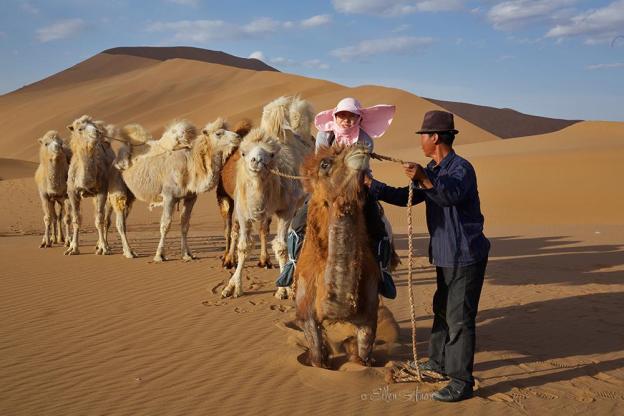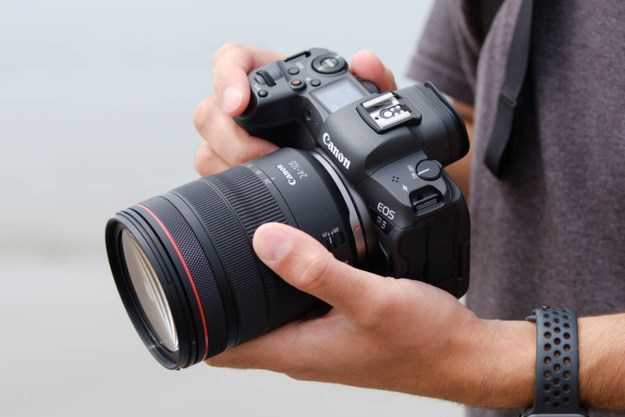
As summer approaches, our first thoughts turn to vacation plans. But this year, maybe it’s time to spice things up. Why spend your vacation lying on the beach when you can make it more adventurous in a special exotic locale? Sometimes the less traveled road is the one where you might discover something that hasn’t been seen, and photographed, by thousands of others.
However, just traveling to an exciting destination doesn’t guarantee you’re going to return home with dramatic photos. To help ensure you get great pictures, we got a few tips from photographer, writer, and world traveler Ellen Anon who just returned from her trip to rural China where she captured some incredible shots.
Chief among Anon’s stops in China included the Badain Jaran Desert located in Alashan (also known as Alxa), west of the Inner Mongolian Autonomous Region, which is famous for its high sand dunes and spectacular views. It is ranked as the third largest desert in China.
She also visited Yangshuo Town in Guilin, Guangxi Province, which is surrounded by mountainous peaks and bordered on one side by the Li River. In the past few years, this town is fast becoming a resort destination for both domestic and foreign travelers.
Anon pointed out that going to rural China is surprisingly very reasonably priced, even with a guide/driver. “Of course, the facilities and amenities in some areas are more basic than in the U.S. You definitely need to be with someone who speaks Mandarin and who can advocate for you because many things end up being renegotiated on the spot,” she says.
Whether your next exotic vacation takes you to the outermost regions of China, the jungles of the Amazon, or even the remote locales of North America, here are some of Anon’s tips to follow, as well as some images from her recent trip.
Research your location
Anon said that virtually every destination has some areas that are repeatedly photographed because they are picturesque. The traditional advice of looking at postcards from the area still rings true, or even better, you can search the Internet before your vacation for pictures of your destination. “The idea isn’t to duplicate these shots exactly but to use them as ideas for subject matter, locations, and what equipment you’ll need. Or, you can use those locations as backdrops for pictures to show family and friends where you’ve been. Once there, ask locals if they have any favorite spots they’d be willing to share. You’d be surprised how often people are willing to share information and guide you to spots where you can get great views.”

Be prepared
If you want good pictures, Anon says, always have your camera with you and ready to shoot. That includes having a fast memory card with plenty of free space on it, as well as extra batteries. Often, it’s the unexpected, unplanned, spontaneous moments that make for the best shots like this one here.

Lighting can make or break an image
Anon says that a location can look spectacular in early morning or even predawn light. Late afternoon through twilight can also be a great time to take pictures, but be careful of midday light, which can cause contrasting and unpleasant photos. “Although you might be on vacation and dreaming of sleeping in each day, if you’re after great shots, you may have to compromise and get up early. Take a nap midday, or stay out shooting in the evening, and then have a late dinner. A great photo isn’t just about the subject matter, it’s the subject matter in great light.”

Avoid distracting elements

Painters have an advantage in that they decide exactly what to include in their paintings, but photographers must usually deal with things that are already there. Anon says the trick is to make sure your subject matter stands out from the background, perhaps because of its size or position in the frame. “You may want to zoom in on your subject or move to get closer to your subject to make them larger in the frame. Equally important is to make sure there aren’t other elements sneaking into the background that are distracting. If the background is distracting, try shooting in aperture priority or manual mode. Also, try shooting wide open by using a larger aperture, such as f/2.8 or f/4, to help keep your subject sharp and in focus, while letting the background become blurry.”

Add a sense of local flavor
If you’re in a foreign country, include some residents in some of your images to convey a sense of the local flavor. “Whenever possible it’s best to first talk with the person you’re wanting to photograph rather than trying to sneak a shot or arrogantly sticking your camera in their face. Even if they speak a language that you don’t, you can communicate your desire to photograph them through gestures and smiles. If they indicate no, respect their wishes. Often, if you approach people openly with a friendly demeanor, they’ll be willing. If you do photograph them, offer to show them the photo on the camera’s LCD screen.” As a last resort, Anon says some people are more willing to let you photograph them if you offer to pay them in some way. “This can be cash, or in some places, it might be with goods such as oranges, cigarettes, candy or hats.”

Watch for changing weather conditions
Anon points out that, yes, weather is unpredictable, but sometimes poor weather causes dramatic lighting and/or mist that adds mystery and mood to your images. “Don’t leave your camera behind if the weather is gloomy. Instead, bring along something to protect your camera from rain. There are dedicated rain covers ranging from $8 to more than $100. Or, you can even use a large clear plastic baggie with a hole cut out for the lens. I personally am a fan of the $8 rain covers that are easy to use and reuse.”

Avoid bright sunlight
This is a standard photography tip that applies when you travel. When photographing people outdoors, don’t force them to stand with the sun shining directly into their eyes – doing so will make them squint and have less-than-flattering expressions. “Instead ask them to stand in open shade and areas that are not directly in bright sun. Then use your flash to fill in any shadows and to help brighten the lighting on them.”

Have a backup plan
“If your camera has two memory card slots, mirror the cards so that you have two copies of your photos. By using a very large card such as what I use – a SanDisk 64GB or 128GB card in one of the slots – you can create an automatic backup of your images as you shoot. Then, reformat the other card after downloading it to your computer. That way if something happens to your computer, you’ll still have a copy of the images. It’s always a good idea to maintain at least two copies of your images.”
Think before you shoot
Most importantly, Anon says, before you start to take a picture, ask yourself what it is that you really want to communicate in that shot. “What is it that’s making you reach for your camera? After you answer that question, think about how you can emphasize the feature that’s attracting you. Maybe you need to change position and get closer, lower or higher. Maybe you need a slow shutter speed or a faster shutter speed. By taking the time to think through exactly what you hope to capture in the shot, you increase the likelihood of making an image that captures what you’re seeing.”

Ellen Anon is a freelance photographer and writer who specializes in expressive photography. She is a co-author of nine books on photography and photo related software, including “See It: Photographic Composition Using Visual Intensity.” Her images are included in collections in several countries, are used by several major companies, and are also used as stock images and in numerous publications.
(Copyright images via Ellen Anon)


